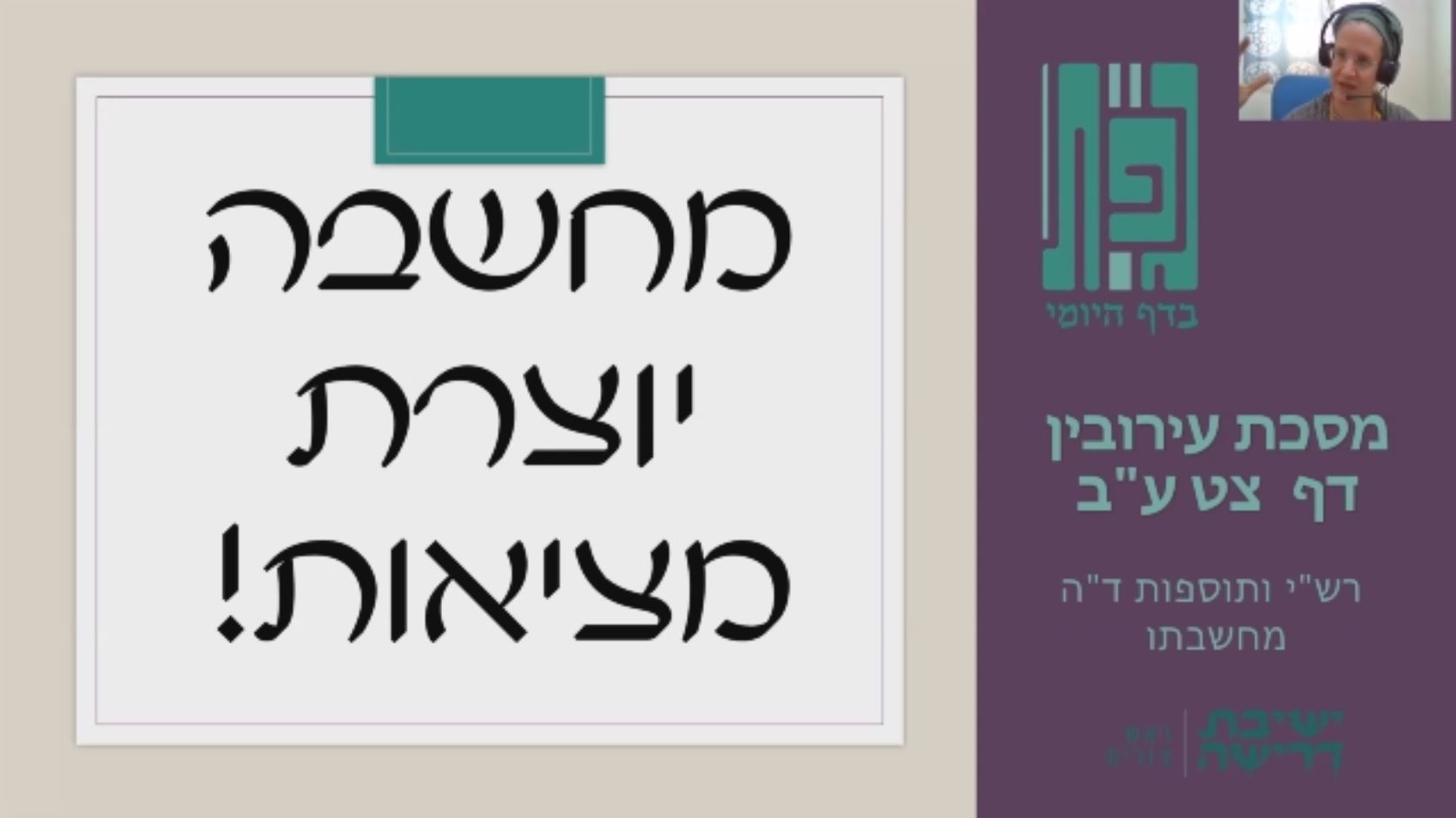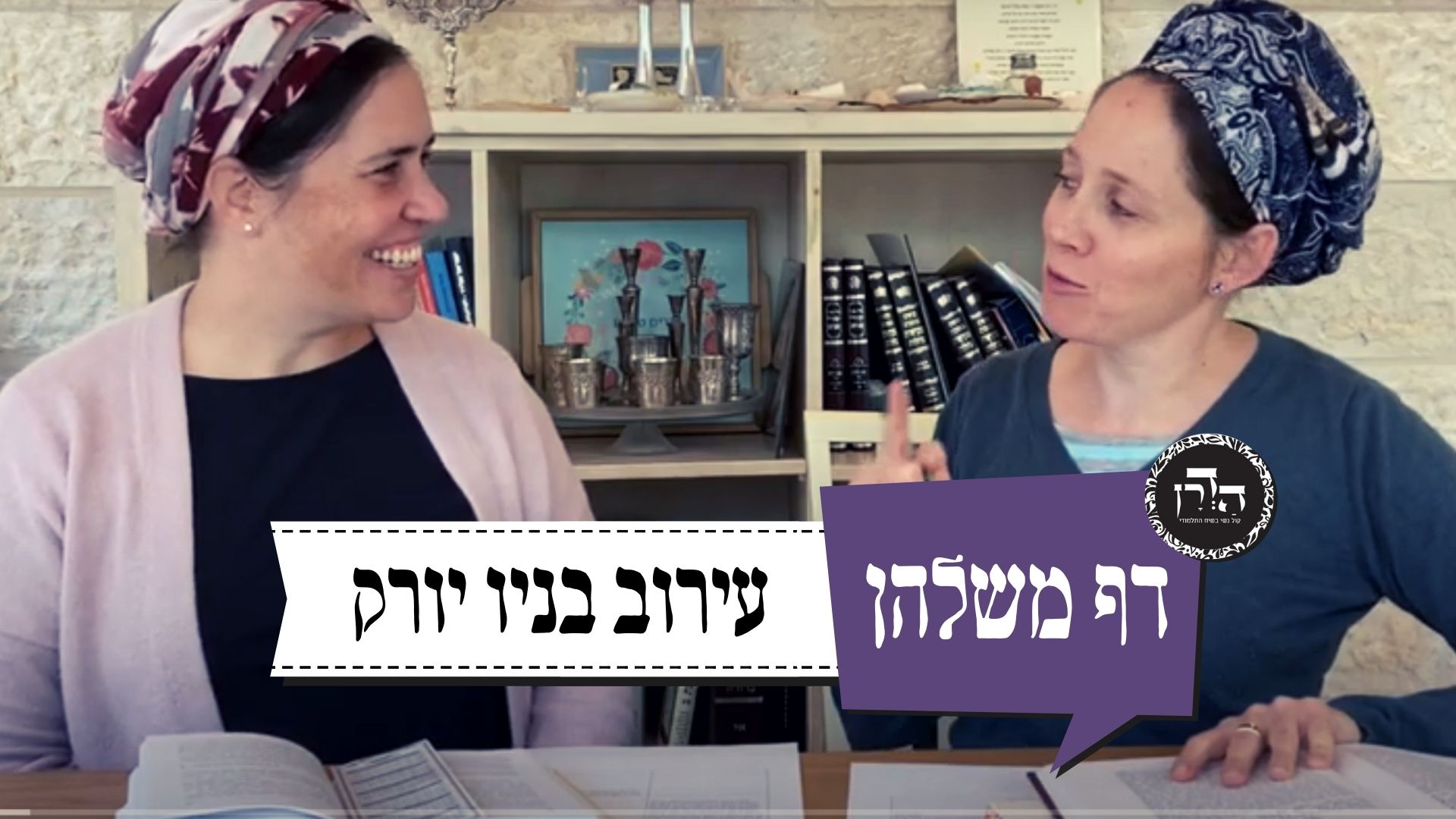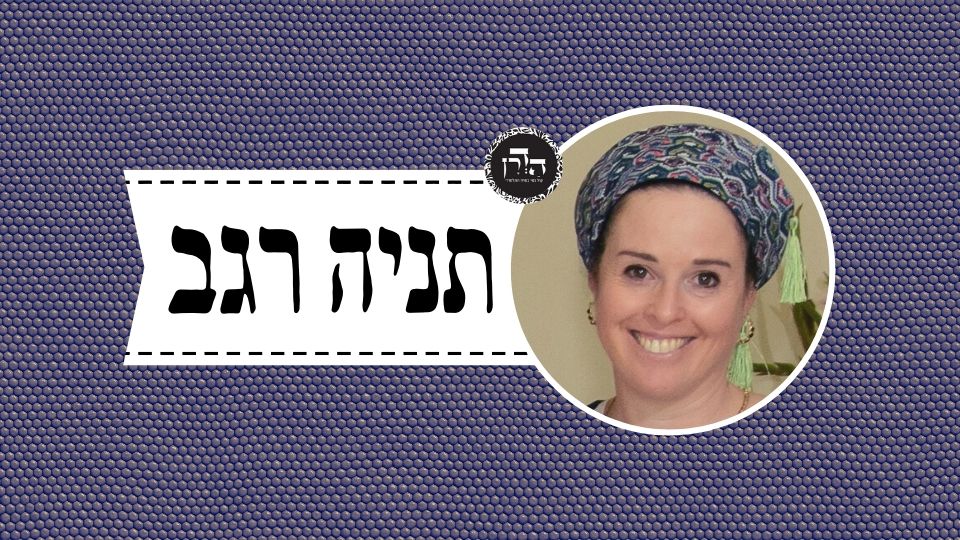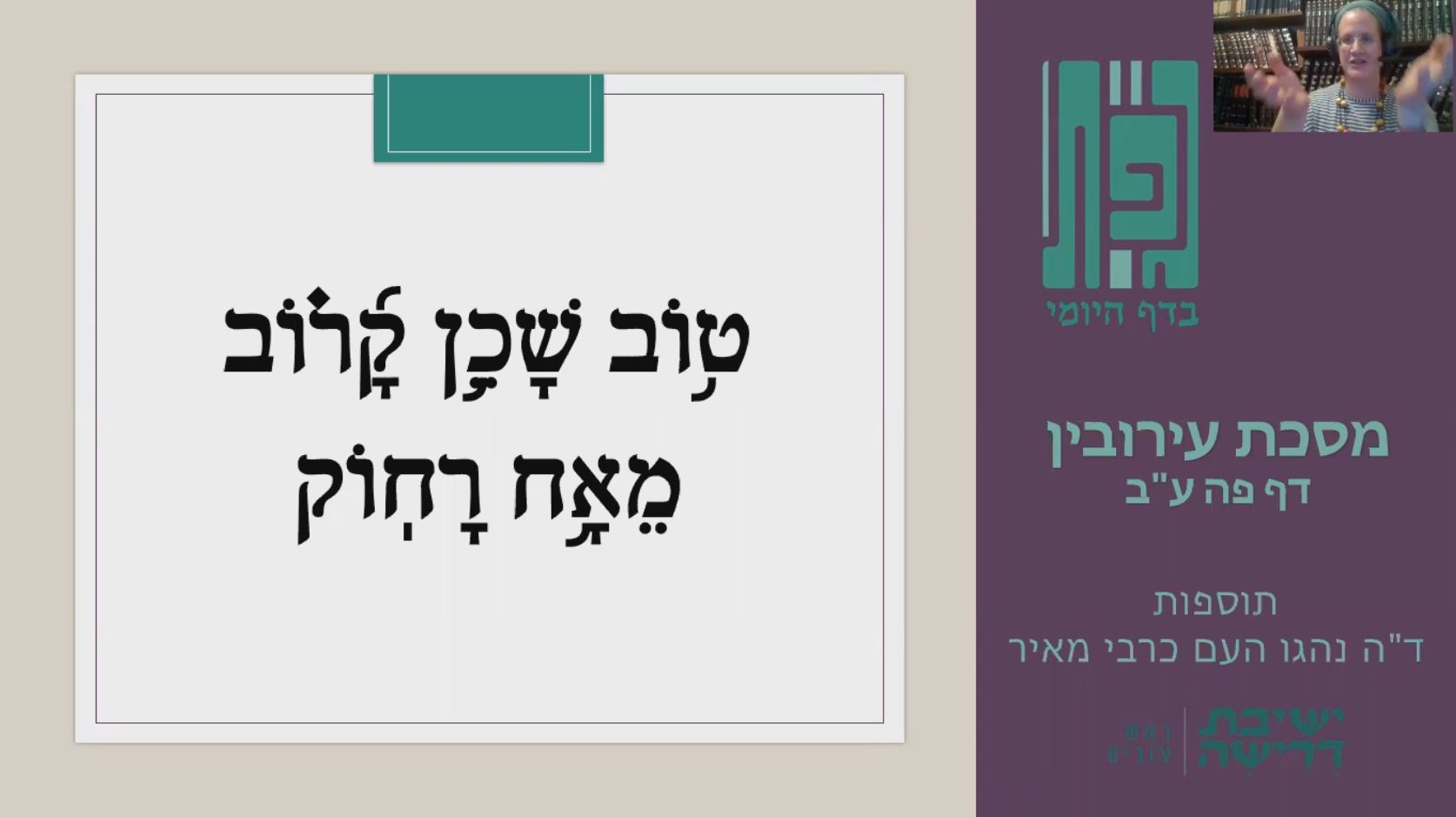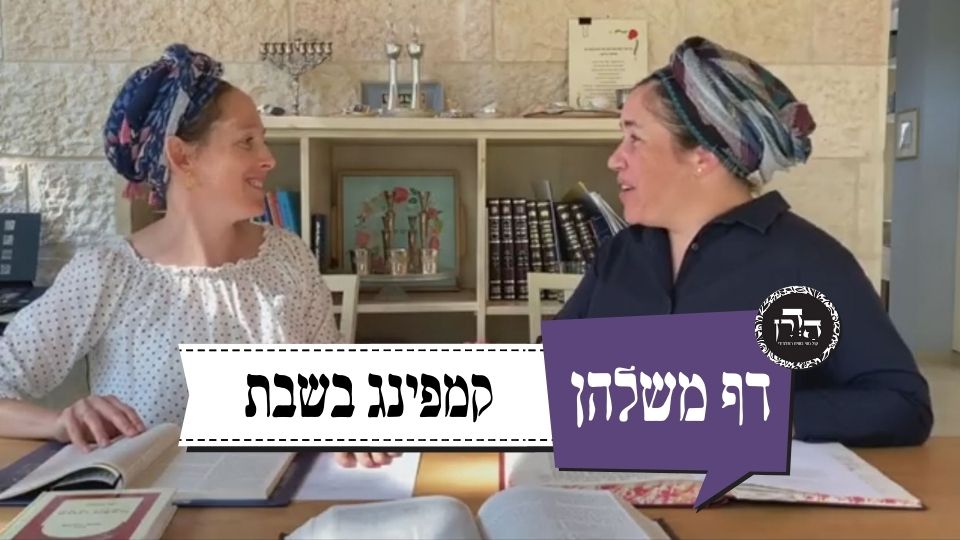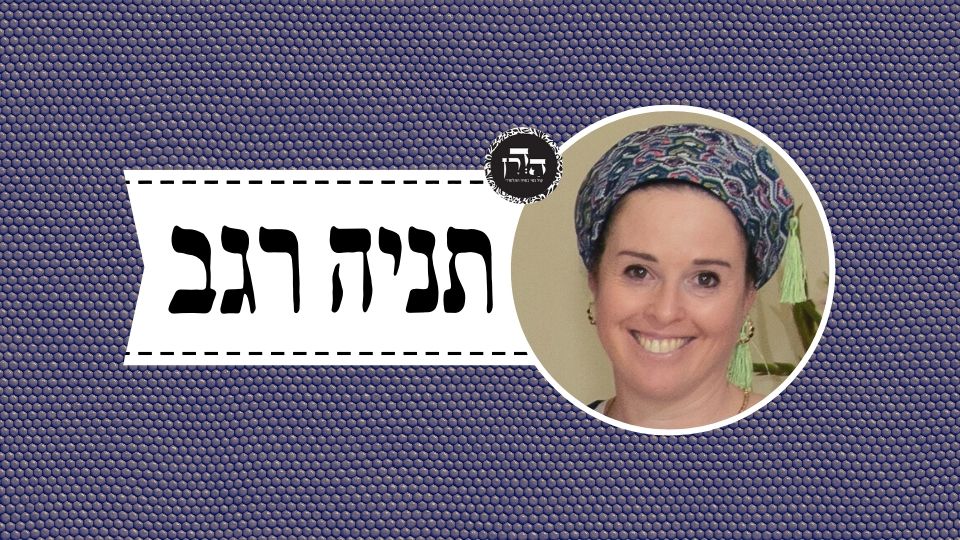הלימוד השבוע מוקדש ע”י אודרי מנדרו לע”נ יחזקאל בן רחל ואברהם.
הלימוד השבוע מוקדש ע”י קרוליין בולג לע”נ פנחס בן מנשה פייזר.
רוצה להקדיש שיעור?

תקציר
כלים
הלימוד השבוע מוקדש ע”י אודרי מנדרו לע”נ יחזקאל בן רחל ואברהם.
הלימוד השבוע מוקדש ע”י קרוליין בולג לע”נ פנחס בן מנשה פייזר.
כלים
העמקה
רוצה להבין מה באמת קורה מתחת לפני השטח של הסוגיה?
שיעורים, פודקאסטים והרחבות של מיטב המורות שלנו יפתחו לך עוד זוויות וכיווני חשיבה.
חדשה בלימוד הגמרא?
זה הדף הראשון שלך? איזו התרגשות עצומה! יש לנו בדיוק את התכנים והכלים שיעזרו לך לעשות את הצעדים הראשונים ללמידה בקצב וברמה שלך, כך תוכלי להרגיש בנוח גם בתוך הסוגיות המורכבות ומאתגרות.
פסיפס הלומדות שלנו
גלי את קהילת הלומדות שלנו, מגוון נשים, רקעים וסיפורים. כולן חלק מתנועה ומסע מרגש ועוצמתי.
עירובין צב
מִי אָמַר רַבִּי יוֹחָנָן הָכִי? וְהָא אָמַר רַבִּי יוֹחָנָן: הֲלָכָה כִּסְתַם מִשְׁנָה. וּתְנַן: כּוֹתֶל שֶׁבֵּין שְׁתֵּי חֲצֵירוֹת, גָּבוֹהַּ עֲשָׂרָה וְרוֹחַב אַרְבָּעָה — מְעָרְבִין שְׁנַיִם, וְאֵין מְעָרְבִין אֶחָד. הָיוּ בְּרֹאשׁוֹ פֵּירוֹת — אֵלּוּ עוֹלִין מִכָּאן וְאוֹכְלִים, וְאֵלּוּ עוֹלִין מִכָּאן וְאוֹכְלִים, וּבִלְבַד שֶׁלֹּא יוֹרִידוּ לְמַטָּה?
Did Rabbi Yoḥanan actually say this, that the halakha is in accordance with Rabbi Shimon’s opinion that all courtyards constitute a single domain, even if each courtyard established an independent eiruv? But didn’t Rabbi Yoḥanan say that the halakha is in accordance with an unattributed mishna, and we learned: With regard to a wall between two courtyards, ten handbreadths high and four handbreadths wide, they establish two eiruvin, one for each courtyard, but they do not establish one eiruv. If there was fruit atop the wall, these, the residents of one courtyard, may ascend from here and eat it, and those, the residents of the other courtyard, may ascend from there and eat it, provided that they do not take the fruit down from atop the wall to the courtyards. According to Rabbi Yoḥanan, all the courtyards are considered a single domain. Why may they not bring the fruit down?
מַאי ״לְמַטָּה״ — לְמַטָּה לַבָּתִּים. וְהָא תָּנֵי רַבִּי חִיָּיא: וּבִלְבַד שֶׁלֹּא יְהֵא זֶה עוֹמֵד בִּמְקוֹמוֹ וְאוֹכֵל, וְזֶה עוֹמֵד בִּמְקוֹמוֹ וְאוֹכֵל!
The Gemara answers: What is the meaning of the word down in this context? It means down to the houses; however, it is indeed permitted to bring the fruit down to the courtyards. The Gemara raises a difficulty: But didn’t Rabbi Ḥiyya explicitly teach in a Tosefta: Provided that neither will this one stand below in his place in his courtyard and eat, nor will that one stand in his place in his courtyard and eat?
אֲמַר לֵיהּ: וְכִי רַבִּי לֹא שְׁנָאָהּ, רַבִּי חִיָּיא מִנַּיִן לוֹ?
Rav Ashi said to Ravina: No proof can be cited from this baraita of Rabbi Ḥiyya with regard to the mishna. If Rabbi Yehuda HaNasi did not explicitly teach it in this manner, from where does his student Rabbi Ḥiyya know it? If a halakha is not taught by the mishna itself, it should not be distorted to have it correspond with a Tosefta.
אִתְּמַר: שְׁתֵּי חֲצֵירוֹת וְחוּרְבָּה אַחַת בֵּינֵיהֶם, אַחַת עֵירְבָה וְאַחַת לֹא עֵירְבָה, אָמַר רַב הוּנָא: נוֹתְנִין אוֹתָהּ לָזוֹ שֶׁלֹּא עֵירְבָה, אֲבָל לְשֶׁעֵירְבָה — לָא. דִילְמָא אָתֵי לְאַפּוֹקֵי מָאנֵי דְבָתִּים לְחוּרְבָּה.
It was stated that amora’im dispute the following case: If there were two courtyards and there was one ruin between them, and the residents of one courtyard established an eiruv for themselves, while the residents of the other courtyard did not establish an eiruv for themselves, Rav Huna said: The Sages confer the right to utilize the ruin to the residents of that courtyard that did not establish an eiruv; however, to the residents of the courtyard that established an eiruv, no, they do not confer the right to utilize the ruin. It is prohibited due to a decree, lest people come to take out vessels from one of the houses to the ruin, which is prohibited, as no eiruv was established with the ruin itself. However, this concern does not extend to the courtyard whose residents did not establish an eiruv. They are not permitted to move objects from their houses to the courtyard, and therefore there is no reason to issue a decree prohibiting the carrying of objects from the courtyard to the ruin.
וְחִיָּיא בַּר רַב אָמַר: אַף לְשֶׁעֵירְבָה, וּשְׁתֵּיהֶן אֲסוּרוֹת. וְאִם תֹּאמַר שְׁתֵּיהֶן מוּתָּרוֹת, מִפְּנֵי מָה אֵין נוֹתְנִין חָצֵר שֶׁלֹּא עֵירְבָה לְחָצֵר שֶׁעֵירְבָה?
And Ḥiyya bar Rav disagreed with Rav Huna and said: Rights to the ruin are conferred to the residents of the courtyard that established an eiruv, and consequently, it is prohibited for residents of both courtyards to carry objects. And if you say that it should be permitted for residents of both to move articles to the ruin, that is incorrect. As if that were so, for what reason did the Sages not confer the right to carry in the courtyard that did not establish an eiruv, to the residents of the courtyard that established an eiruv? If there is no cause for concern, it should always be permitted to the residents of a courtyard that established an eiruv to carry from their courtyard to a different courtyard whose residents did not establish an eiruv.
הָתָם, כֵּיוָן דְּמִנַּטְרִי מָאנֵי דְבָתִּים בְּחָצֵר, אָתֵי לְאַפּוֹקֵי. הָכָא בְּחוּרְבָּה, כֵּיוָן דְּלָא מִנַּטְרִי מָאנֵי דְחָצֵר בְּחוּרְבָּה, לָא אָתֵי לְאַפּוֹקֵי.
The Gemara refutes this contention: There, in the case of courtyards, since the vessels from the houses are protected in the courtyard as well, there is a concern lest people come to take them out from the house to the courtyard, where they could be confused with those vessels already in the courtyard, and they might come to move those objects into the other courtyard. Here, in the case of a ruin, since the vessels from the courtyard are not protected in the ruin, there is no concern lest people come to take out the vessels from the courtyard into the ruin. Therefore, it is possible that residents of both courtyards would be permitted to utilize the ruin.
אִיכָּא דְּאָמְרִי, חִיָּיא בַּר רַב אָמַר: אַף לְשֶׁעֵירְבָה, וּשְׁתֵּיהֶן מוּתָּרוֹת. וְאִם תֹּאמַר: שְׁתֵּיהֶן אֲסוּרוֹת — לְפִי שֶׁאֵין נוֹתְנִים חָצֵר שֶׁלֹּא עֵירְבָה לְחָצֵר שֶׁעֵירְבָה. הָתָם, כֵּיוָן דְּמִנַּטְרִי מָאנֵי דְבָתִּים בְּחָצֵר — לָא שָׁרוּ בְּהוּ רַבָּנַן, דְּאָתֵי לְאַפּוֹקֵי. אֲבָל בְּחוּרְבָּה לָא מִנַּטְרִי.
Some say a different version of the previous discussion. Ḥiyya bar Rav disagreed with Rav Huna and said: The ruin belongs even to the residents of the courtyard that established an eiruv, and it is permitted for residents of both to carry in the ruin. And if you say they should both be prohibited to do so in accordance with the argument presented above, that the Sages do not confer the right to carry in the courtyard that did not establish an eiruv to the residents of the courtyard that established an eiruv, this proof can be refuted. There, since the vessels from the houses are protected in the courtyard, the Sages did not permit carrying them, due to the concern lest people come to take them out from the house to the courtyard and from there to the other courtyard. However, in the case of a ruin, the vessels are not protected in the ruin, and therefore, there is no cause for concern.
מַתְנִי׳ גַּג גָּדוֹל סָמוּךְ לְקָטָן — הַגָּדוֹל מוּתָּר, וְהַקָּטָן אָסוּר. חָצֵר גְּדוֹלָה שֶׁנִּפְרְצָה לִקְטַנָּה — גְּדוֹלָה מוּתֶּרֶת וּקְטַנָּה אֲסוּרָה, מִפְּנֵי שֶׁהִיא כְּפִתְחָהּ שֶׁל גְּדוֹלָה.
MISHNA: If a large roof was adjacent to a small roof, and the boundary between them was no wider than ten cubits, use of the large one is permitted, i.e., one may bring objects up to the roof from the house below and carry them on the roof, and use of the small one is prohibited. A similar halakha applies to a large courtyard that was breached into a small one, in a manner that one entire side of the small courtyard was breached, but the breach was less than ten cubits; it is permitted for the residents of the large courtyard to carry, but it is prohibited for the residents of the small one to do so. The rationale for this difference is because in that case, the legal status of the breach is like that of the entrance of the large courtyard. As the breach in the wall of the larger courtyard is surrounded on both sides by the remaining portions of that wall, and the breach is no greater than ten cubits wide, its legal status is like that of an entrance in the wall of the courtyard, and therefore it is permitted to carry in the large courtyard. With regard to the small courtyard, however, since one entire side of the small courtyard was breached, there remains no partition whatsoever on that side and carrying in that courtyard is therefore prohibited.
גְּמָ׳ לְמָה לֵיהּ לְמִיתְנֵי תַּרְתֵּי?
GEMARA: The Gemara poses a question: Why does the mishna teach the same halakha twice? Why is it necessary to repeat the ruling with regard to both roofs and courtyards when the cases are apparently identical?
לְרַב, קָתָנֵי גַּג דּוּמְיָא דְחָצֵר: מָה חָצֵר מִנַּכְרָא מְחִיצְתָּא, אַף גַּג נָמֵי מִנַּכְרָא מְחִיצְתָּא.
The Gemara answers: According to the opinion of Rav, with regard to the lenient ruling that the residents may carry on a roof, the repetition comes to teach the halakha of a roof similar to that of a courtyard: Just as a courtyard, its partitions are conspicuous, so too a roof, its extended partitions, based on the principle: Extend and raise the walls of the house, must be conspicuous for it to be permitted for the residents to carry on their account. In other words, the roof must not extend beyond the walls of the house.
וְלִשְׁמוּאֵל, גַּג דּוּמְיָא דְחָצֵר: מָה חָצֵר דְּקָא דָרְסִי לַהּ רַבִּים, אַף גַּג נָמֵי דְּקָא דָרְסִי לֵיהּ רַבִּים.
Whereas according to the opinion of Shmuel, the repetition should be understood in the opposite manner, as it comes to teach the halakha of a roof similar to that of a courtyard: Just as a courtyard is a place where multitudes tread, so too, the roof is a place where multitudes tread. However, if it is not used by many people, even the small roof is permitted, as the principle: Extend and raise the walls of the house, is applied to the wall between the houses, despite the fact that the partition is not conspicuous.
יָתֵיב רַבָּה וְרַבִּי זֵירָא וְרַבָּה בַּר רַב חָנָן, וְיָתֵיב אַבָּיֵי גַּבַּיְיהוּ, וְיָתְבִי וְקָאָמְרִי: שְׁמַע מִינַּהּ מִמַּתְנִיתִין דָּיוֹרֵי גְדוֹלָה בַּקְּטַנָּה, וְאֵין דָּיוֹרֵי קְטַנָּה בַּגְּדוֹלָה.
Rabba, Rabbi Zeira, and Rabba bar Rav Ḥanan were sitting, and Abaye was sitting beside them, and they sat and said: Learn from the mishna that the rights of the residents of the large courtyard extend into the small one, but the rights of the residents of the small courtyard do not extend into the large one.
כֵּיצַד? גְּפָנִים בַּגְּדוֹלָה — אָסוּר לִזְרוֹעַ אֶת הַקְּטַנָּה. וְאִם זָרַע — זְרָעִין אֲסוּרִין,
How so? If there are vines in the large courtyard, it is prohibited to sow crops in the small one, even at a distance of four cubits, due to the prohibition against planting other food crops in a vineyard. And if he sowed crops, the seeds are prohibited. As the small courtyard is considered part of the large one, the vines in the larger courtyard render the seeds in the smaller courtyard prohibited.
גְּפָנִים מוּתָּרִין. גְּפָנִים בַּקְּטַנָּה — מוּתָּר לִזְרוֹעַ אֶת הַגְּדוֹלָה.
The vines, however, are permitted, as the small courtyard does not extend into and impact upon the large one. The converse is also true: If there are vines in the small courtyard, it is permitted to sow other crops in the large one ab initio, even if they are not planted four cubits away from the vines, because the vines are not considered to be located in the larger courtyard, and therefore there is no prohibition whatsoever.
אִשָּׁה בַּגְּדוֹלָה וָגֵט בַּקְּטַנָּה — מִתְגָּרֶשֶׁת. אִשָּׁה בַּקְּטַנָּה וְגֵט בַּגְּדוֹלָה — אֵינָהּ מִתְגָּרֶשֶׁת.
Likewise, if there were two adjacent courtyards, and a wife, who owned both courtyards, was standing in the large courtyard, and her husband threw her a bill of divorce into the small courtyard, she is divorced. Her presence in the larger courtyard extends to the smaller one, and she is therefore considered to be standing in the small courtyard. If, however, the wife was in the small courtyard and the bill of divorce was thrown into the large one, she is not divorced.
צִבּוּר בַּגְּדוֹלָה וּשְׁלִיחַ צִבּוּר בַּקְּטַנָּה — יוֹצְאִין יְדֵי חוֹבָתָן. צִיבּוּר בַּקְּטַנָּה וּשְׁלִיחַ צִבּוּר בַּגְּדוֹלָה — אֵין יוֹצְאִין יְדֵי חוֹבָתָן.
Likewise, with regard to communal prayer, if the congregation was in the large courtyard, and the prayer leader was in the small one, they fulfill their obligation through his prayer, as the congregation is considered to be in the small one as well. However, if the congregation was in the small courtyard, and the prayer leader was in the large one, they do not fulfill their obligation.
תִּשְׁעָה בַּגְּדוֹלָה וְיָחִיד בַּקְּטַנָּה — מִצְטָרְפִין. תִּשְׁעָה בַּקְּטַנָּה וְאֶחָד בַּגְּדוֹלָה — אֵין מִצְטָרְפִין.
The same principle applies to a prayer quorum: If there were nine men in the large courtyard and one man in the small one, they join together to form the necessary quorum of ten, as the small courtyard is subsumed within the large one, and the individual is considered to be in the large courtyard. However, if there were nine men in the small courtyard and one in the large one, they do not join together.
צוֹאָה בַּגְּדוֹלָה — אָסוּר לִקְרוֹת קְרִיאַת שְׁמַע בַּקְּטַנָּה. צוֹאָה בַּקְּטַנָּה — מוּתָּר לִקְרוֹת קְרִיאַת שְׁמַע בַּגְּדוֹלָה.
Furthermore, if there was excrement in the large courtyard, it is prohibited to recite Shema in the small one, as the excrement is considered to be in the small courtyard as well, and it is prohibited to recite Shema in the presence of excrement. If, however, there was excrement in the small courtyard, it is permitted to recite Shema in the large one.
אֲמַר לְהוּ אַבָּיֵי: אִם כֵּן, מָצִינוּ מְחִיצָה לְאִיסּוּר. שֶׁאִילְמָלֵי אֵין מְחִיצָה, מַרְחִיק אַרְבַּע אַמּוֹת וְזוֹרֵעַ, וְאִילּוּ הַשְׁתָּא אֲסוּרָה!
Abaye said to them: If so, we have found a partition that causes prohibition. According to these principles, the existence of a partition renders sowing crops prohibited; in the absence of a partition sowing the crops would have been permitted due to their distance from the vines. Ostensibly, this is a counterintuitive conclusion. As, were there no partition at all, it would be sufficient to distance oneself four cubits from the vine and sow the crop, whereas now that the area is divided into two courtyards by means of a partition, it is prohibited to sow the crop in the entire small courtyard.
אֲמַר לֵיהּ רַבִּי זֵירָא לְאַבָּיֵי: וְלֹא מָצִינוּ מְחִיצָה לְאִיסּוּר?! וְהָא תְּנַן: חָצֵר גְּדוֹלָה שֶׁנִּפְרְצָה לִקְטַנָּה — גְּדוֹלָה מוּתֶּרֶת וּקְטַנָּה אֲסוּרָה, מִפְּנֵי שֶׁהִיא כְּפִתְחָהּ שֶׁל גְּדוֹלָה.
Rabbi Zeira said to Abaye: And didn’t we find a partition that causes prohibition? But didn’t we learn in the mishna: With regard to a large courtyard that was breached into a small one, it is permitted for the residents of the large courtyard to carry, but it is prohibited for the residents of the small one to do so. That is because in that case, the legal status of the breach is like that of the entrance of the large courtyard.
וְאִילּוּ הִשְׁוָה אֶת גִּיפּוּפֶיהָ גְּדוֹלָה נָמֵי אֲסוּרָה!
And if he were to even its protrusions by constructing partitions in the larger courtyard so that the large courtyard no longer protruded beyond the smaller one, carrying in the large courtyard would also be prohibited, as it would now be completely breached into the smaller courtyard. Apparently, in this case, construction of additional partitions causes prohibition.
אֲמַר לֵיהּ, הָתָם סִילּוּק מְחִיצּוֹת הוּא.
Abaye said to Rabbi Zeira: The two cases are not comparable, as there, adding partitions in order to even the protrusions is not considered establishment of partitions. On the contrary, it is effectively the removal of partitions. These partitions are designed to negate the original partitions of the courtyard.
אֲמַר לֵיהּ רָבָא לְאַבָּיֵי: וְלֹא מָצִינוּ מְחִיצָה לְאִיסּוּר? וְהָא אִתְּמַר:
Rava said to Abaye: And didn’t we find a partition that causes prohibition? But wasn’t it stated:




